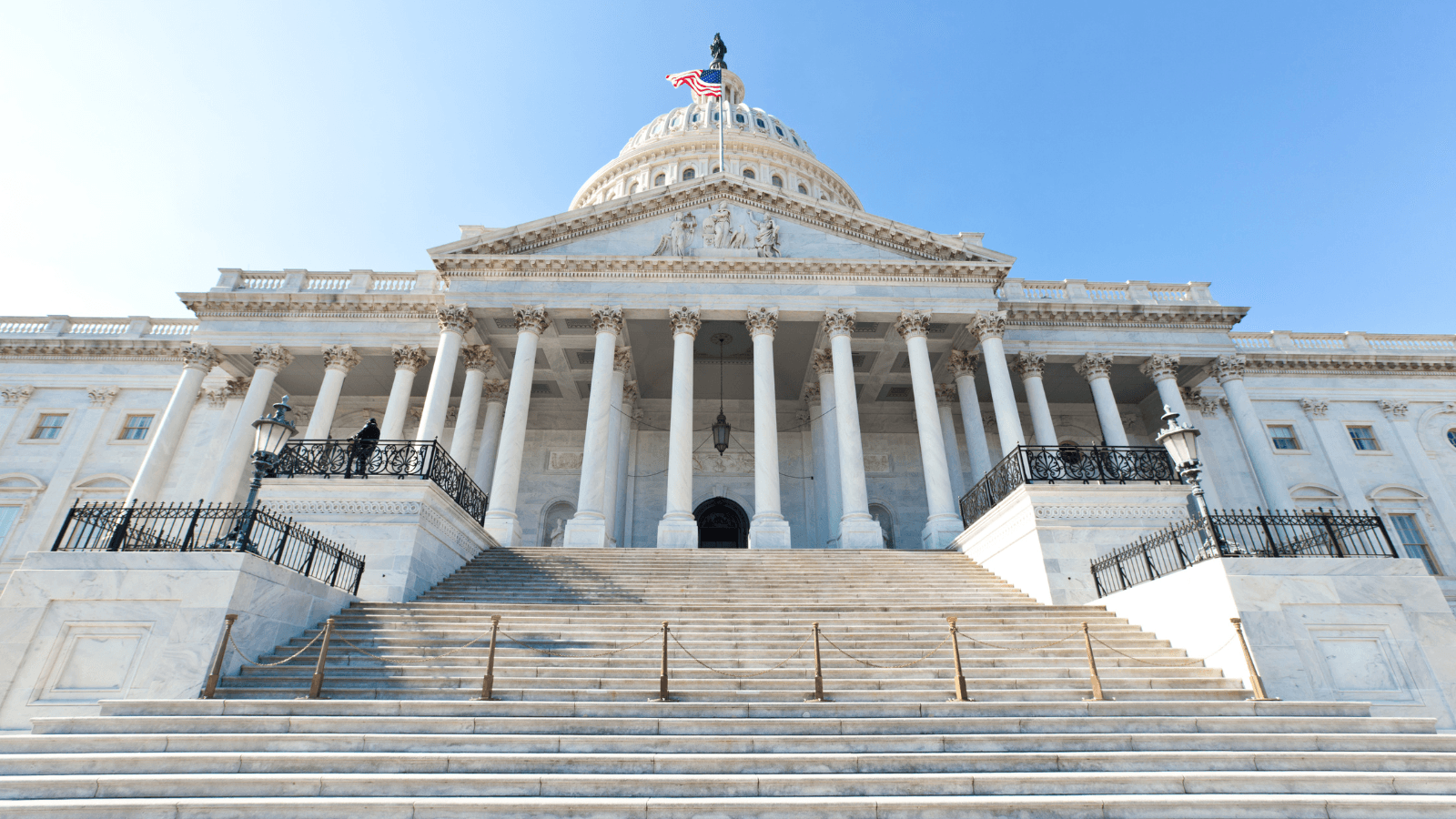
On December 6, 2022, EEN's Vice President for Science and Policy Rev. Dr. Jessica Moerman testified before House Select Committee on the Climate Crisis. Below is a written version of her testimony.
Good afternoon. Thank you, Chairwoman Castor, Ranking Member Graves, and Members of the Committee for convening this hearing. I thank every member of this committee for their leadership and common commitment to working towards making America’s energy and other critical systems the cleanest in the world – a goal that every American can be proud of and that is indispensable for giving our children and grandchildren the bright and healthy future they deserve.
I am honored to testify on behalf of the Evangelical Environmental Network. We are the largest evangelical group in America with a ministry to care for God’s creation, with over 5 million pro-life Christians have taken action with us over the last five years for clean air, clean water, and a safe climate.
Our mission at the Evangelical Environmental Network is to faithfully and obediently live out the Biblical mandate to care for God’s creation and our vision is for a world where all God’s children have the hope and expectation for a healthy environment and safe climate to thrive in.
As evangelical Christians, we believe that all human life is sacred; that each person conceived is of equal and innate value and dignity, and that all human life is worthy of protection. At the Evangelical Environmental Network, we are pro-life from conception to natural death – a theology we share with the National Association of Evangelicals, but also one we share with Catholic social teaching and the guidance of Pope Francis in his encyclical letter, Laudato si' on care for our common home (24 May 2015).
As pro-life evangelicals, we have a special concern for children – both born and unborn – and have a moral and Biblical mandate to defend the health of all God’s children. We want children to be born healthy and unhindered by the ravages of pollution and climate-fueled extreme heat that can rob them of their God-given potential even before they take their first breath.
Simply put, for us, climate care is a matter of life.
Over the tenure of this committee, we have seen banner year after banner year for transformative policy to defend life from the harmful impacts of climate and pollution.
And the majority of these wins were bipartisan – from the Great American Outdoors Act and the Energy Act of 2020 to the Congressional Review Act for methane to the Bipartisan Infrastructure Law and CHIPS and Science Act. Even key climate pieces in the Inflation Reduction Act have bipartisan origins.
As we look to the 118th Congress, I sit before you today with a simple message. The work is not done and we cannot afford two years of gridlock.
As a climate scientist – and frankly as a mother who -- like most people in this room -- wants to pass down a healthy future and safe climate to my kids – I strongly urge the members of the committee to keep the momentum up and continue to work together.
For the remainder of my testimony, I’d like to highlight two areas that are set for strong bipartisan action:
- Defending Life and Wisely Stewarding our Resources by Cutting Wasteful Methane Leaks
- Harnessing the Power of God’s Creation through Natural Climate Solutions
Cutting Methane Leaks: Defending Life and Wisely Stewarding Our Resources
We are grateful for the prosperity our modern energy system has brought, but there has been a shadow side to carbon-based energy – namely its emission of planet-warming greenhouse gases and toxic pollutants that contaminate the air we breathe and the water we drink.
Medical research shows that children are among the most at risk for developing life-threatening conditions from exposure to fossil fuel pollution and that fossil fuel combustion is a leading environmental threat to children’s health.[1] A multitude of studies link living in proximity to natural gas development and methane production to birth defects to the brain, spine, and spinal cord[2],[3] and to lower birth weight[4], which is associated with breathing problems and immature lungs, bleeding inside the brain, serious inflammation of the intestines (necrotizing enterocolitis), and long-term complications like cerebral palsy, deafness, blindness, and developmental delay.
As an evangelical pastor, I take seriously what the Bible says in Proverbs 13:22: that it’s our duty to leave a good inheritance to future generations. Birth defects, breathing problems, and severe health complications are no inheritance to leave to our children.
This isn’t a small or isolated problem: in the United States, the American Lung Association reports that more than 40 percent of Americans live in areas with unhealthy, polluted air, causing up to 200,000 American deaths every year.[5] Mapping of oil and gas infrastructure shows that over 17 million Americans, including 3.2 million children, live, work, or go to school within the 0.5 mile health threat radius of an oil and gas facility.[6] Over 85% of the medical studies[7] that have studied the gas industry’s impact on health find that pollution from oil and gas facilities and infrastructure is highly detrimental to the health of adults too – this includes heart failure,[8] asthma,[9],[10] and the exposure to known carcinogens.[11]
Not only does leaking oil and gas infrastructure spew harmful pollution like methane, benzene, other volatile organic compounds (VOCs), and toxins that threaten our children’s right to achieve their God-given potential and an abundant life, methane is greenhouse gas 86 times more potent than CO2 in the first twenty years – making fugitive and leaking methane as an imperative for any hope in keeping temperature below 1.5°C by 2050 or sooner. Methane is responsible for at least one-quarter of the climate warming we are experiencing today.[12] Warmer temperatures produce more smog, increasing asthma, another serious health concern.
Because of methane’s significantly stronger warming punch and shorter lifespan in the atmosphere, reducing methane emissions is the fastest way to slow the escalating rate of global warming while defending the health of all God’s children.
That’s why we are grateful for key policies that tackle methane leaks and emissions passed this Congress as part of the Infrastructure Investment and Jobs Act (aka Bipartisan Infrastructure Law) and the Inflation Reduction Act. This includes the $4.7 billion investment to states from the Bipartisan Infrastructure Law to plug orphaned oil and gas wells and the Inflation Reduction Act’s Methane Emissions Reduction Program, which will incentivize larger gas operators to reduce their methane emissions quickly and efficiently.
Policies encouraging oil and gas operators to seal wasteful methane leaks and responsibly steward our nation’s precious natural resources are more important than ever during this time when American families and the world cannot afford any wasted drop.
State-of-the-art analysis using ground-based facility-scale measurements and validated with aircraft observations finds that 12 million metric tons of methane is leaked and wasted each year.[13] Much of these emissions come from unaddressed abnormal “super-emitter” events – the infrequent but very large emissions events that arise from some improper conditions at oil and gas sites. Low-producing wells are also a large source of leaked methane. Although they produce only 6% of total US methane and oil production, these low-producing wells are found to release 50% of all methane emissions.[14]
Nationally these porous wells spew enough methane to supply over 3.6 million homes in the US every year. That’s $1.3 billion in wasted energy. Put another way, these leaks amount to more than 10% of the gas these wells produce. And this wasted methane does not disappear harmlessly into the wind. It drifts up to our atmosphere where it worsens climate change, and it settles into the lungs, hearts, and brains of our children and grandkids.
The good news is that there are no technical barriers to rapidly reducing emissions from the oil and natural gas industry. The technology and innovation required to stop these leaks is already at hand and actually in-use in some areas when required by various jurisdictions. Critical practices include: requiring frequent leak detection and repair programs which are estimated to reduce leaks by 90% and reclaim 4.5 million tons of methane; equipment upgrades to newer innovations including the replacement of gas-driven pneumatic equipment, compressors and dehydrators, and reducing routine venting and flaring of gas from oil wells, storage tanks, and emissions from well-completions.[15]
However, despite these readily available technologies, industry on the whole has shown little or no willingness to voluntarily put these innovations into place. Jesus teaches in Luke 16:10 “Whoever can be trusted with a little can also be trusted with a lot, and whoever is dishonest with a little is dishonest with a lot.”
Before trusting industry with more methane drilling, Congress must secure a commitment that it can responsibly manage the precious natural resources we already entrust to them and reduce methane leaks. As the geopolitical landscape requires increased energy security and independence, we must capture this wasted gas first before sinking fortunes into drilling new wells that will only continue to harm our children and contaminate God’s amazing creation.
Looking ahead, the 118th Congress plays a critical role to play in encouraging wise stewardship of our precious natural resources and protection of our children’s health and future. Wise stewardship is actually good for business. Reducing methane leaks through frequent leak detection and repair, adopting innovative new equipment, and regular site monitoring means more methane will make it to market. Industry stands to increase their bottom lines by plugging wasteful methane leaks and recapturing fugitive methane emissions, making cutting methane pollution a win-win-win.
Another opportunity for better health, fiscal responsibility, and fairness for the American taxpayer is to reform our oil and gas bonding structure. At EEN, we are grateful for the investments in the Bipartisan Infrastructure Law to plug orphaned and abandoned wells, but it is fiscally irresponsible and unfair for Americans taxpayers to foot the bill (not to mention the associated health care burdens) to pay to clean up the messes of the oil and gas industry.
The $4.5 billion investment in the BIL, however, will only cover part of the problem of orphaned wells[16] that companies have left to the us. This is a problem that would not exist if proper bonding requirements were in place from the start or had been updated since the 1950’s.[17] Without adequate bonding requirements, we are doomed to repeat these mistakes yet again and saddle the next generation with despoiled land, water, and air and a billion-dollar price tag for a mess they didn’t make.
Orphaned oil and gas wells are a known significant source of methane emissions and danger to our climate. In fact, research conducted by McGill University recently found that abandoned oil and gas wells are the 10th largest source of anthropogenic methane emissions in the US. These orphaned wells also pollute our water and lands and jeopardize wildlife. On federal public lands, there are currently at least 15,000 orphaned oil and gas wells, and while the Interior Department is currently spending $250 million in order to clean them up, this funding will do nothing to prevent even more orphaned wells from threatening our public lands, communities, and climate in the future. That’s because federal oil and gas bonds are based on rates that were first set over 60 years ago and have not been updated since – not even for inflation or changes in technology that now allow for deeper and more destructive wells to be drilled – making the minimum amounts woefully inadequate for coming even close to matching what it actually costs to properly plug and fully reclaim an abandoned well today. And since the Government Accountability Office has found that the Bureau of Land Management requires just the minimum bond amount 82 percent of the time, that means that the vast majority of wells on our public lands are substantially underbonded. Taxpayers already could be on-the-hook for as much as nearly $14 billion to ensure that all of the wells that have already been drilled on public lands are plugged and reclaimed, and this shortfall will just continue to worsen until Congressional action to secure federal bonding reform, such as is included in Representative Leger-Fernández and Representative Lowenthal introduced legislation that address federal bonding rates.
We urge the 118th Congress to come together to defend our children’s health and the American Taxpayer by demanding that new bonding requirements that cover the full cost of real remediation. This includes actual third-party bonding per permit – not self or blanket bonding. These issues are correctly and thoroughly discussed in an outstanding white paper entitled Broken Promises by Conservatives For Responsible Stewardship.[18]
Finally, even with today’s high energy prices, analysis shows that changing bonding, instituting a methane fee, and increasing royalties will not increase costs for Americans but is necessary to hold industry accountable.[19]
Harnessing the Power of God’s Creation with Natural Climate Solutions
To solve the climate crisis, we need to harness the power of God’s creation and advance natural climate solutions. According to peer-reviewed research, natural climate solutions “can provide 37% of cost-effective CO2 mitigation needed through 2030 for a >66% chance of holding warming to below 2°C. One-third of this cost-effective national climate solutions mitigation can be delivered at or below 10 USD MgCO2−1”.[20]
America’s farmers, foresters, and ranchers are among the most dedicated stewards of God’s creation and are a key part of the solution to climate change. To solve the climate crisis and make our food producers more resilient and less vulnerable to climate-fueled extreme weather, we need to unleash the innovation of the American farmer.
Just last week, I met with farmers across Iowa and the Midwest. Over and over again they told me that extreme weather was making what is an already challenging job even more difficult. Extreme rainfall events, at the rate of 4-inches of rainfall per hour, that had never been seen before are now common occurrence. As these storms dump massive amounts of rainfall, soil they spent years enriching washed away in the matter of hours. Investments in terraces, designed to hold 2 inches of rainfall per hour, were destroyed. Intense derechos – massive, straight-line storms with hurricane and tornado-force winds, heavy rains, and flash floods – stripped away soil and destroyed farm equipment, buildings, and critical infrastructure.
On the other hand, Iowa farmers are currently facing two back-to-back years of drought. Many told me they had exhausted their moisture reserves last year and they don’t have any left if drought persists for a third year.
While farmers plan for variability in the weather – that is simply part of doing business – what I heard is that the increasingly extreme weather fueled by climate change, the whiplash of unprecedented floods followed by unprecedented drought, and unpredictable timing for planting and harvesting as spring temperatures come sooner and summer lasts longer, is making life and business even more difficult on the farm. Climate change is also making it harder for soils to naturally store carbon. Warming causes widespread soil carbon losses by speeding up the decay of soil organic matter. Farming is hard enough these days, and it doesn’t need to made any harder. Climate change is doing just that.
The good news is that soil and water conservation practices that make farmers more resilient to extreme weather, like no-till and cover cropping, is also smart climate mitigation that sequesters carbon and increases soil organic matter for increased productivity. Cover cropping protects soils from being stripped away by extreme rainfall and winds, allows for rapid water infiltration during floods, and better retains soil moisture to buffer against drought.
The Inflation Reduction Act’s $40 billion for agriculture, forestry and rural development is the investment that our farmers, foresters, and ranchers need to put in place the sustainable agriculture practices they desire to implement but find financially difficult to do. This includes nearly $20 billion in funding for critical USDA and Farm Bill programs and technical assistance that farmers told us they need, including the Agricultural Conservation Easement Program (ACEP), Conservation Stewardship Program (CSP), Environmental Quality Incentives Program (EQIP) and Regional Conservation Partnership Program (RCPP). In addition, it includes $14 billion for rural development, including rural broadband to support the development of renewable energy and precision agriculture.
Next year, the 118th Congress is tasked with reauthorizing the Farm Bill. The message we have received from farmers is to increase – not cut – Farm Bill authorization levels for conservation programs and practices. These programs are historically oversubscribed with large backlogs.[21] Many farmers who wish to access these programs and implement sustainable and climate-smart agriculture practices simply cannot because there is not enough funding. For example, in FY2020, USDA only funded 27% of eligible program applications received for EQIP, 35% for CSP, and 43% for Agricultural Management Assistance (AMA).
Congress must come together to preserve investment levels for conservation agriculture set in the Inflation Reduction Act. Additionally, the 118th Congress should also invest in farmer-to-farmer and research-to-farmer learning pilot programs that are critical avenues for farmers to learn about and implement sustainable and climate-smart agriculture practices. We also call for the passage of the Growing Climate Solutions Act, which will establish a much-needed Verifier Certification Program providing a uniform carbon measuring method that ensures farmers a fair price and an accountable carbon market. The Growing Climate Solutions Act provides a way for the agriculture community–especially family farms–to increase income through market-based incentives, enrich the soil, sequester carbon, and empower American farmers as part of the climate solution.
Again, I thank this committee for your work but there is much more to be done. I urge you to continue to work together in the 118th – our children’s health depends on its.
[1] Perera F. (2017) Pollution from Fossil-Fuel Combustion is the Leading Environmental Threat to Global Pediatric Health and Equity: Solutions Exist. Int J Environ Res Public Health. 2017;15(1):16. doi:10.3390/ijerph15010016
[2] Lisa M. McKenzie, Ruixin Guo, Roxana Z. Witter, David A. Savitz, Lee S. Newman, and John L. Adgate, Birth Outcomes and Maternal Residential Proximity to Natural Gas Development in Rural Colorado, Environmental Health Perspectives doi:10.1289/ehp.1306722.
[3] Casey J.A., et al., “The association between natural gas well activity and specific congenital anomalies in Oklahoma, 1997-2009,” Environment International, Volume 122, January 2019, 381-388, https://www.sciencedirect.com/science/article/pii/S0160412018317999?via=ihub
[4] Stacy SL, Brink LL, Larkin JC, Sadovsky Y, Goldstein BD, Pitt BR, et al. (2015) Perinatal Outcomes and Unconventional Natural Gas Operations in Southwest Pennsylvania. PLoS ONE 10(6): e0126425. doi:10.1371/journal.pone.0126425.
[5] Bowe B, Xie Y, Yan Y, Al-Aly Z. Burden of Cause-Specific Mortality Associated With PM2.5 Air Pollution in the United States. JAMA Netw Open. 2019;2(11):e1915834. doi:10.1001/jamanetworkopen.2019.15834
[6] https://oilandgasthreatmap.com/threat-map/
[7] Hays J, Shonkoff SBC (2016) Toward an Understanding of the Environmental and Public Health Impacts of Unconventional Natural Gas Development: A Categorical Assessment of the Peer- Reviewed Scientific Literature, 2009-2015. PLoS ONE 11(4): e0154164. doi:10.1371/journal. pone.0154164
[8] McAlexander TP, Bandeen-Roche K, Buckley JP, Pollak J, Michos ED, McEvoy JW, Schwartz BS. Unconventional Natural Gas Development and Hospitalization for Heart Failure in Pennsylvania. J Am Coll Cardiol. 2020 Dec 15;76(24):2862-2874. doi: 10.1016/j.jacc.2020.10.023. PMID: 33303076; PMCID: PMC7735256.
[9] Rasmussen S.G., et al., “Association Between Unconventional Natural Gas Development in the Marcellus Shale and Asthma Exacerbations,” JAMA Internal Medicine, 2016, 176(9), 1334–1343, https://jamanetwork.com/journals/jamainternalmedicine/fullarticle/2534153
[10] Willis, M. D., et al., “Unconventional natural gas development and pediatric asthma hospitalizations in Pennsylvania, Environmental Research, 166, 402- 408, October 2018, https://www.ncbi.nlm.nih.gov/pubmed/29936288
[11] McKenzie, L.M., et al., “Ambient Nonmethane Hydrocarbon Levels Along Colorado Northern Front Range: Acute and Chronic Health Risks,” Environmental Science Technology, April 17, 2018, 52(8):4514-4525, https://pubs.acs.org/doi/10.1021/acs.est.7b05983
[12] lissa B Ocko et al 2021 Environ. Res. Lett. 16 054042
[13] Alvarez, RA et al. (2018), “Assessment of Methane Emissions from the U.S. Oil and Gas Supply Chain,” Science 361, 186 (available at https://science.sciencemag.org/content/361/6398/186).
[14] Mark Omara, Daniel Zavala-Araiza, David R. Lyon, Benjamin Hmiel, Katherine A. Roberts, and Steven P. Hamburg https://doi.org/10.1038/s41467-022-29709-3, Nature Communications: April 19, 2022
[15] Clean Air Task Force (2020). Reducing Methane from Oil and Gas: A Path to a 65% Reduction in Sector Emissions. Availbable at https://cdn.catf.us/wp-content/uploads/2020/04/21092556/Path_to_65pc_OG_reduction-Dec2020_update.pdf
[16] IOGCC, Idle and Orphan Oil and Gas Wells 14 (2019), available at https://iogcc.ok.gov/sites/g/files/gmc836/f/documents/2021/2020_03_04_updated_idle_and_orphan_ oil_and_gas_wells_report.pdf.
[17] GAO, BLM Should Address Risks from Insufficient Bonds to Reclaim Wells 11 (Sept. 2019), available at https://www.gao.gov/assets/gao-19-615.pdf.
[18] https://www.conservativestewards.org/wp-content/uploads/2021/10/CRS-bonding-analysis_FINAL.pdf
[19] Oil & Gas Reform Won’t Raise Prices at the Pump, https://www.taxpayer.net/wp-content/uploads/2021/10/OG- Reform-and-Gas-Prices-Primer.pdf.
[20] Bronson W. Griscom, et al., “Natural Climate Solutions,” Proceedings of the National Academy of Sciences (vol 114, no. 44): October 31, 2017.
[21] Congressional Research Service (2022). Farm Bill Primer: Conservation Title. Updated January 25, 2022.






